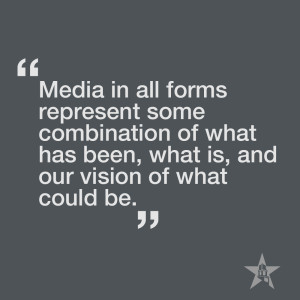“Media cannot reflect society, if society is not reflected in the media.” This slogan for Creative Access, an organization devoted to increasing diversity in the media, is a call for greater representation of minorities in popular media.
The goal of media is broad and varied – entertainment, advocacy, education, escapism – and within media the emphasis placed on each of these goals varies. Regardless, media in all forms represent some combination of what has been, what is, and our vision of what could be. There are two versions of representation problems with minority groups in mass media: the absence of representation and the portrayal of the single story.
 Failure to represent a minority is preemptive erasure. It implies that people of this minority group simply do not exist or worse, are somehow unworthy of acknowledgement. Minorities who do not see their identity represented by people they interact with in their daily life stand to benefit the most from media representation. Representation is essential for aspects of identity that are easy to conceal such as gender identity, sexual identity, or religion. Similarly, even if racial minorities, people with disabilities, and age minorities are not isolated from other individuals of their minority group, they may turn to the media for representations of people in their minority group with relatable ambitions.
Failure to represent a minority is preemptive erasure. It implies that people of this minority group simply do not exist or worse, are somehow unworthy of acknowledgement. Minorities who do not see their identity represented by people they interact with in their daily life stand to benefit the most from media representation. Representation is essential for aspects of identity that are easy to conceal such as gender identity, sexual identity, or religion. Similarly, even if racial minorities, people with disabilities, and age minorities are not isolated from other individuals of their minority group, they may turn to the media for representations of people in their minority group with relatable ambitions.
Lack of representation is an issue, for example, in popular superhero films. Superheroes are models of human ideals that have been magnified and made larger-than-life. They are utopic, god-like champions of good. Yet if film portrays superheroes almost exclusively as white, straight, cis-males, it implies that these characteristics are somehow necessary to the message – that they are part of the ideals being portrayed.
The problem of the single story, as it is described by Chimamanda Ngozi Adichie, is the acceptance of the representation of an individual or culture by a single trait. “The consequence of the single story is this,” Adichie said, “It robs people of dignity. It makes our recognition of our equal humanity difficult. It emphasizes how we are different rather than how we are similar.” The single story is a narcotic, offering one dimension to placate our desire to understand someone while shutting our eyes to their complexity.
 As a result of the Chapel Hill murders, social media and some news outlets have revived discussion of long-standing concerns about the single story the media portrays about Muslims. Fariha Naqvi-Mohamed of the Huffington Post wondered if the reason the media did not call the murders a hate crime was because the victims did not represent “the burly, secretive, conspiring and dangerous image of Muslims so commonly thrust around in the media….European media did a better job of covering the events then American media. That in itself speaks volumes.” Balanced representation is essential because it is powerful: it will either polarize or unite. Despite social media, mass media still holds many of the volume controls determining whose voices are heard across the nation.
As a result of the Chapel Hill murders, social media and some news outlets have revived discussion of long-standing concerns about the single story the media portrays about Muslims. Fariha Naqvi-Mohamed of the Huffington Post wondered if the reason the media did not call the murders a hate crime was because the victims did not represent “the burly, secretive, conspiring and dangerous image of Muslims so commonly thrust around in the media….European media did a better job of covering the events then American media. That in itself speaks volumes.” Balanced representation is essential because it is powerful: it will either polarize or unite. Despite social media, mass media still holds many of the volume controls determining whose voices are heard across the nation.
Admittedly it is about as effective to throw accusations at ‘the media’ as it is to jump out of the path of a tsunami, but all of us are to some degree in positions to affect change by being conscientious. Writers, artists, and musicians are primary contributors to popular media and, therefore, have the greatest responsibility. However people in all fields – business, communications, political science, history, psychology, etc. – will in all likelihood at some point be influential in how representation is handled. Sometimes the task is as simple as choosing images for a presentation, but it is situations like these, where the images used are not the primary focus, where we are most likely to resort to a corrupt default, an imitation of flawed mass media.
More importantly, we are all media consumers. It is ineffectual to sit back and wait for mass media to change. Media content changes in fits and starts that must constructively accumulate to affect large-scale changes. Searching out multi-dimensional representations of minorities can be a challenging but rewarding task. Supporting creators and media outlets that offer better representation leads to greater quantities of balanced media being produced.
We live at a time when so much media content is available that we can easily consume large quantities of media without ever encountering a perspective that challenges us; as such, we must be deliberate.
